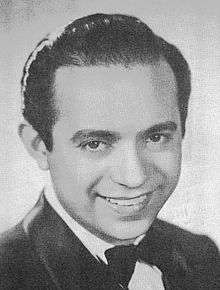Jan Savitt
Jan Savitt (born Jacob Savetnick; September 4, 1907 – October 4, 1948), known as "The Stokowski of Swing",[1] from having played violin in Leopold Stokowski's orchestra,[2] was an American bandleader, musical arranger, and violinist.
Jan Savitt | |
|---|---|
 | |
| Background information | |
| Birth name | Jacob Savetnick |
| Born | September 4, 1907 Shumsk, Russian Empire |
| Origin | Philadelphia, Pennsylvania, USA |
| Died | October 4, 1948 (aged 41) Sacramento, California |
| Genres | Jazz |
| Occupation(s) | Bandleader, arranger, musician |
| Instruments | Violin |
| Associated acts | The Top Hatters; George Tunnell |
Early life and education
Savitt was born in Shumsk, then part of the Russian Empire (now part of Ukraine) and reared in Philadelphia. He evidenced musical ability an early age and began winning conservatory scholarships in the study of the violin. He was offered the position of concert master in Leopold Stokowski's Philadelphia Symphony Orchestra, but turned it down, preferring to continue his studies at Curtis Institute. About a year later, believing himself ready, he joined Stokowski and the association continued for seven years, during which time Savitt gained further laurels as a concert soloist and leader of a string quartet. Savitt was married to model Barbara Ann Stillwell from 1940 until his death in 1948, and had two daughters with her, Devi Marilyn and Jo Ann. Jo Ann was married to Joel Douglas, son of Kirk, from 2004 until her death in 2013.
Career
In 1938, Jan Savitt & His Top Hatters broadcast from 5–5:30 pm every Tuesday, Wednesday, Thursday, and Friday as the KYW staff orchestra at KYW/NBC in Philadelphia. Saturday's weekly broadcast was one hour, coast-to-coast. The group also played at the Earl Theatre and performed with The Andrews Sisters and The Three Stooges.
He got his start in popular music some time later as music director of KYW, Philadelphia, where he evolved the unique "shuffle rhythm" which remained his trademark. Numerous sustaining programs created such a demand for the "shuffle rhythm" that Savitt left KYW to form his own dance crew.
Savitt's band was notable for including George "Bon Bon" Tunnell,[3] one of the first African American singers to perform with a white band. Tunnell's recording with Savitt included Vol Vistu Gaily Star (co-composed by Slim Gaillard) and Rose of the Rio Grande. Helen Englert Blaum, known at the time as Helen Warren, also sang with Savitt during the war years.
Savitt recorded short pieces for the National Broadcasting System's Thesaurus series, probably in the 1940s. These were pieces radio stations used as 'fillers' just prior to network programs, which would begin precisely on the hour or half-hour. Disc 1143 in the Thesaurus catalogue features four selections by the Jan Savitt Orchestra on one side of the 33 1/3 transcription: "I'm Afraid the Masquerade is Over "; "If I Didn't Care"; "Ring Dem Bells", and "Romance Runs in the Family".
Death
Shortly before arriving in Sacramento, California, with his orchestra on Saturday, October 2, 1948, for a concert scheduled for that evening at Memorial Auditorium, Savitt was stricken with a cerebral hemorrhage and taken to Sacramento County Hospital. Savitt died on October 4, with his wife at his bedside.[4] He is buried in Forest Lawn Memorial Park (Glendale) California
The Top Hatters
These musicians played with Savitt as The Top Hatters:[5]
- Al Leopold, Charles Jensen, Cutty Cutshall, Ed Clausen, Frank Langone, Gabe Galinas, George White, Harold Kearns, Harry Roberts, Howard Cook, Irv Leshner, Jack Hansen, Jack Pleis, James Schultz, Johnny Austin, Johnny Warrington, Maurice Evans, Morris Rayman, Sam Sachelle.
Selected discography
- The Top Hatters (1939–1941), Decca Jazz Heritage Series, 1967
References
- Billboard June 27, 1942
- Granger, Maurice (November 29, 1941). "Bandstand Notes" (PDF). Movie-Radio Guide. 11 (8): 41. Archived from the original (PDF) on January 20, 2015. Retrieved January 20, 2015.
- "Pop Chronicles 1940s Program #3". 1972.
- Source: New York Times, October 5, 1948, p. 25
- "Jon Savitt And His Top Hatters". Discogs. Retrieved April 11, 2015.
External links
- Wynn, Ron. Jan Savitt at AllMusic